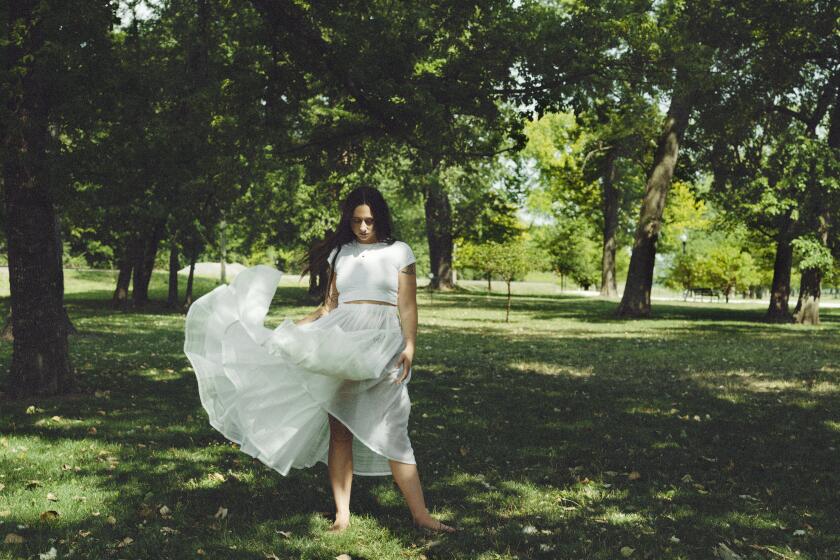Kim Gordon never fully said ‘Bye Bye’ to L.A. Why she’s back, with a TikTok hit to boot
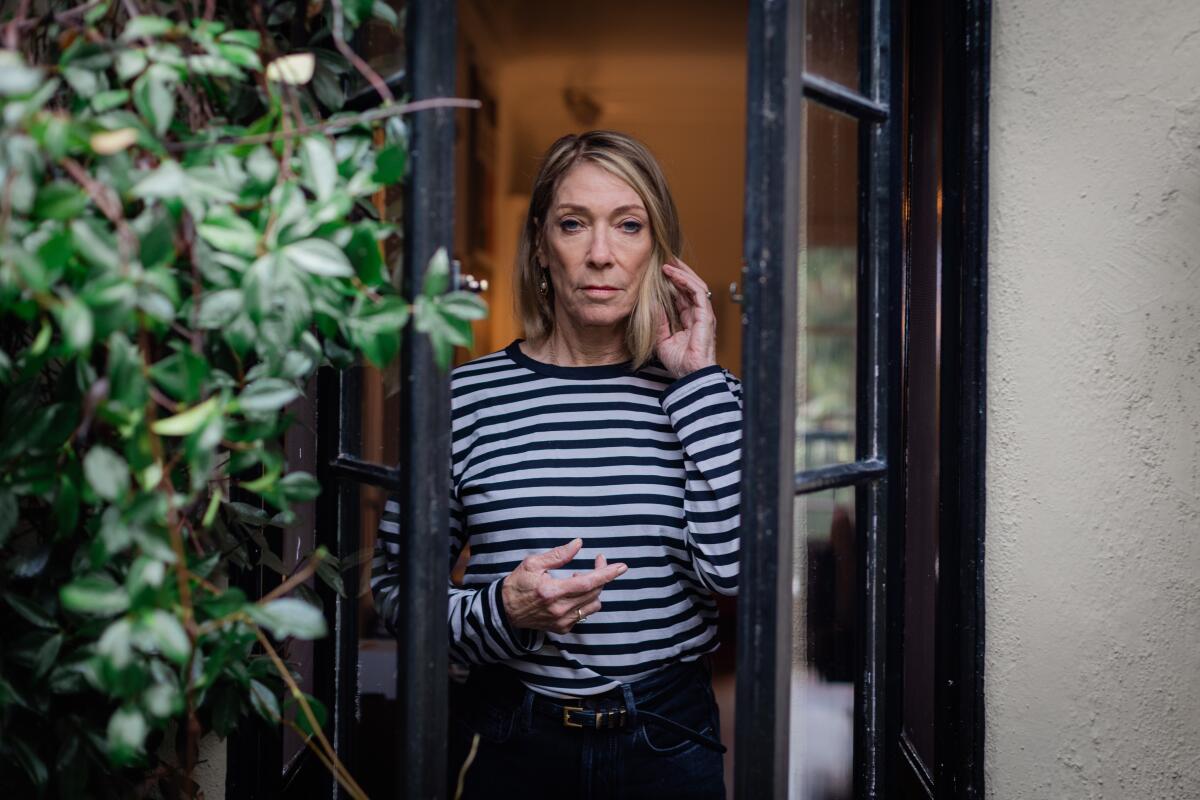
- Share via
For Kim Gordon, returning to Los Angeles was once her least likely destiny.
She largely grew up here, and as an aspiring young artist, she’d been desperate to escape SoCal suburbia and the commercial imperative she felt in Los Angeles.
So she left for Manhattan, inspired by the examples of Merce Cunningham and Robert Rauschenberg, of the scene at Andy Warhol’s Factory and the Judson dance collective. In New York, she thrived as a painter, an underground style icon and, most famously, as a member of the influential noise-rock band Sonic Youth.
“I also felt like L.A. was just a town about money,” recalls Gordon, who now lives in the hills of Los Feliz. “At some point, it switched. It was maybe 2008, and somehow L.A. started looking more quaint. And New York became what it has really always been, which is about money.”
Ever since Sonic Youth ended in 2011, along with her marriage to band co-founder Thurston Moore, Gordon has embraced a diverse flurry of projects. She’s put renewed focus on her gallery work and embarked on a series of collaborations, including the experimental guitar duo Body/Head with Bill Nace. She has performed live improvisations at L.A.’s Museum of Contemporary Art, the Louvre in Paris and elsewhere with choreographer Dimitri Chamblas, who interacts with Gordon as she unleashes driving patterns of distortion on guitar.
At age 70, she is two albums into a vibrant solo music career. On March 8, she released “The Collective,” an uncompromising blend of noise and melody, bursts of avant-garde guitar and underground hip-hop. It’s a sound that makes sense in the context of her long career but without sounding like an echo from her past. The album’s 11 songs are defiantly of the moment and a direct result of her return to L.A.
On a recent rainy afternoon, Gordon steps into a coffeehouse on Hillhurst Avenue, looking much as she has since the early ’90s, in a shiny black raincoat, her straight blond hair cropped into a crisp bob. It’s her third interview of the day as she prepares for an upcoming solo tour set to land at L.A.’s Regent Theater on Wednesday.
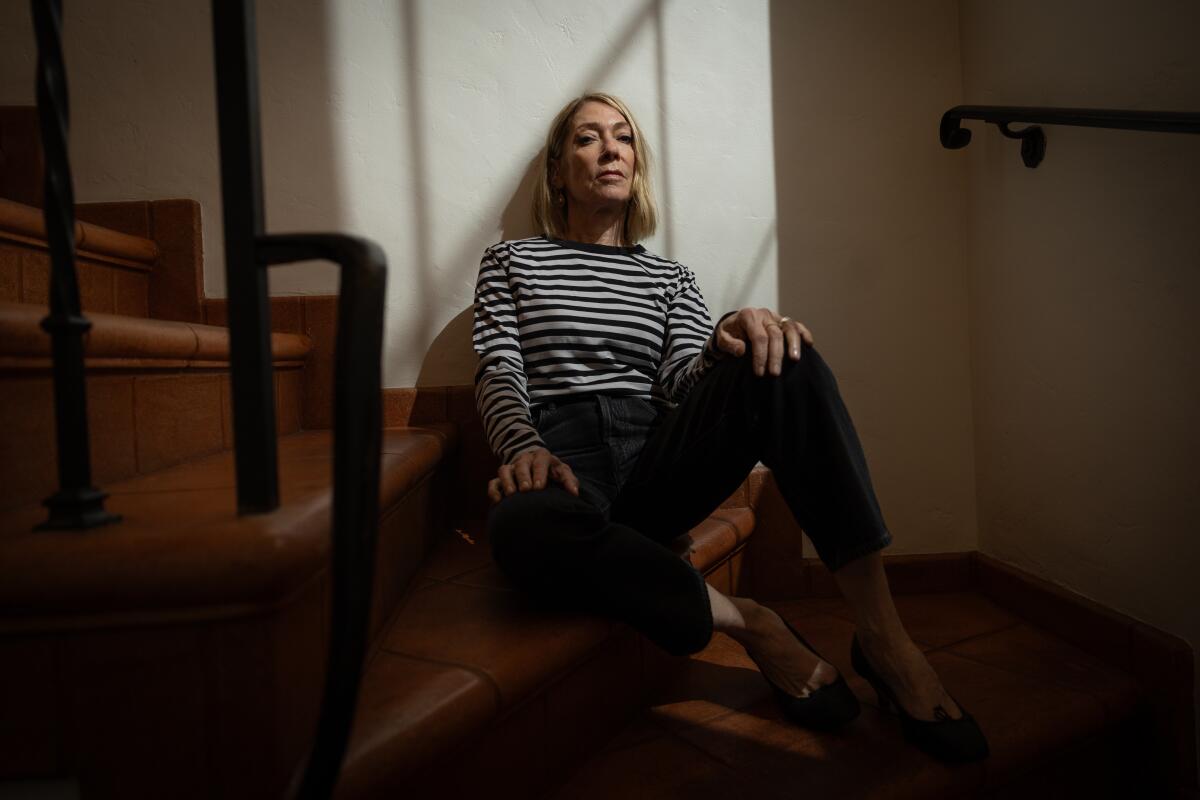
“It’s exciting. It’s a little nerve-wracking. I have to memorize all those lyrics,” she says with a laugh.
In Los Angeles, she’s found a key collaborator in producer and co-writer Justin Raisen, who recorded her solo albums at his home studio in Glassell Park, starting with “No Home Record” in 2019. A modernist with a taste for the raw and unpredictable, Raisen has recently worked with artists who stretch from Lil Yachty and Kid Cudi to John Cale and the Yeah Yeah Yeahs.
“I actually never really intended to make a solo record,” Gordon says with a smile. “I accidentally met Justin Raisen, and he kept bugging me to make a record. After we initially made something together, I was like, ‘OK, I like his sensibility.’”
Her first track with Raisen was “Murdered Out,” a 2019 electronic beat of anxious foreboding with Gordon’s voice on edge warning: “Murdered out of my heart/Covered in black matte spray/Will you see when I’m not there?”
“The thing about collaborations is somehow, when they’re working, they give you a certain confidence to really reach for ideas and take risks that maybe you wouldn’t on your own,” Gordon says.
Her interest in hip-hop stretches back at least to her first time hearing LL Cool J’s debut album, “Radio,” in 1985, and its influence was sometimes felt in her work with Sonic Youth. She was joined by Public Enemy’s Chuck D on the band’s song “Kool Thing,” and in 1993 Sonic Youth, recorded the woozy “I Love You Mary Jane” with Cypress Hill for the hugely influential rap-rock movie soundtrack from “Judgment Night.” She also mingled beats and noise in a 2000 collaboration with Ikue Mori and DJ Olive that Sonic Youth released on its SYR indie label.
The new songs are part of that same lineage.
“The reason it sounds relevant and still her is because she’s more open to danger and taking chances than new popular artists,” Raisen says later. “She’s willing to take those chances, and she’s willing to question.”
The title of “The Collective” is an idea inspired by “The Candy House,” a novel by Jennifer Egan that describes the human impact of an app that allows users to plug into the experiences and memories of anyone who uploads into the collective and a mysterious company called Mandala.
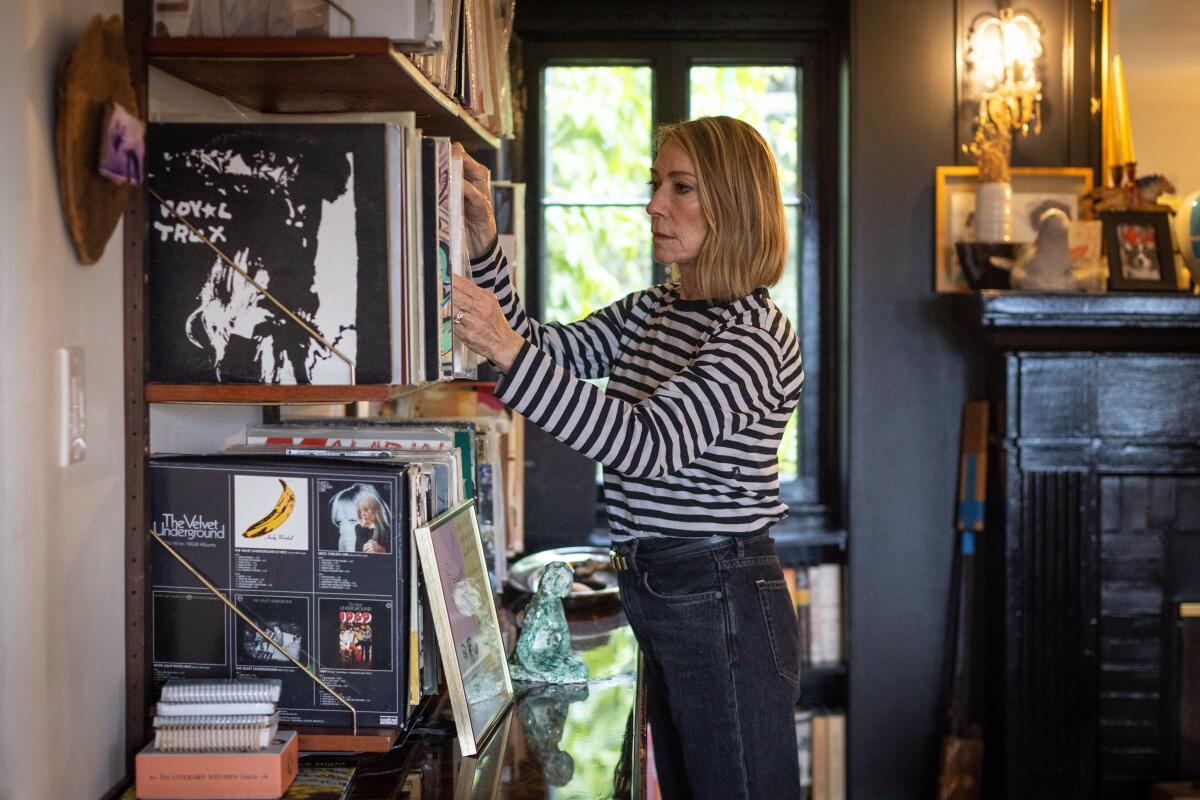
“The catch is you have to upload your own memories and experiences in order to be part of the access that’s making yourself vulnerable,” Gordon says. “I thought it was sort of close to where we are now already in technology. The record, to me, feels a little sci-fi in a sense.”
On the cover is a blurry image of a hand holding a phone photographed by musician Twig Harper. It was shot at a Body/Head show last year at the Gagosian Gallery in Beverly Hills. “I guess when you play live with an audience, we do become kind of a collective, whether you like it or not,” she says. “It’s part of this experience.”
The album opens with “ Bye Bye,” a track of swirling, ominous tension, as tough beats collide with grinding bursts of her guitar. The effect is gorgeously imperfect as her vocal then rattles off an otherwise mundane packing list, her delivery detached yet quietly obsessed: “Hoodie, toothpaste, brush, foundation/Contact solution, mascara, lip mask, eye mask/Ear plugs, travel shampoo, con-di-tion-er …”
“It was such a compelling beat, and I thought it’d be cool to contrast it with something really banal like a to-do packing list,” she says with a laugh. “I’m limited as a singer, so there are things that I’m aware of that I can do using space. It’s weird. When I have the right tone in my earphones — with an effect or something — it gives me a certain confidence. It’s like I transform into another person.”
That unconventional vocal style was established during her time in Sonic Youth, where it fit easily amid the band’s dissonant noise rock, even as it occasionally reached MTV and the ’90s commercial airwaves in the form of “Kool Thing” and “Bull in the Heather.” Gordon’s spoken vocals are as much avant-garde as they are directly inspired by the speaking-vocal style of the ’60s girl group the Shangri-Las.
But it’s been a new discovery for at least some younger listeners astonished by what they are hearing in “ Bye Bye,” the new album’s first single.
With the song’s January release, Gordon unexpectedly became a TikTok sensation, as both longtime fans and young women discovering her for the first time posted videos of themselves lip-syncing to the song’s shopping list lyrics or just listening. One young woman in headphones posted how she’ll “Never have to make another packing list again,” as she’s seen on-camera shoving items from the lyrics into a backpack.
A red-haired woman with a cartoon mouse tattoo on her bicep posted: “I think Kim Gordon just cured my fear of aging.” Another young listener in Poland just nods her head to the beat, and writes: “Być jak Kim Gordon!” (“Be like Kim Gordon!”)
The band’s vocalist and mastermind, Katie Crutchfield, talks about her latest Southern rock-inspired album, “Tigers Blood,” out Friday.
“As a fan, it’s just hilarious and awesome to watch what happened on TikTok,” Raisen says. “Some are new kids who don’t know that she was in Sonic Youth, and they’re literally just with the song and packing a suitcase in the videos and just being like, ‘This [is] hard. I like this.’”
In the music video, Gordon’s daughter, Coco Gordon Moore, is a young woman escaping the comforts of home through a bedroom window and making a run for it. She’s seen again in the video for Gordon’s “I’m a Man,” lounging at home as a young man in a fringed western coat spies on her longingly — maybe less for Coco herself than for her life as a woman. The video mingles grainy 8mm footage with clips from vintage western movies, as Gordon’s vocals take on the persona of confused masculinity:
“I’m not ideal/I’m a person/I won the war, but lost my way/But I can buy as much as anyone/I like to shave my beard just so/manicure my nails/put on a skirt/But at the end of the day/I lost my way/Don’t make me have to hide, or explain, what I am inside.”
The lyrics were partly inspired by the example of conservative politicians, including Republican Sen. Josh Hawley of Missouri, who has been “complaining like he’s a victim of femininity or feminism,” Gordon says. “It’s very whiny and dangerous.”
During the 2014 induction of Nirvana into the Rock & Roll Hall of Fame, Gordon was one of four women to join surviving members of the band and fill in for the late Kurt Cobain. She was there with Joan Jett, Annie Clark (a.k.a. St. Vincent) and Lorde. Gordon performed an especially intense, agonized “Aneurysm” that she described in her memoir as “a four-minute-long explosion of grief, where I could finally let myself feel the furious sadness of Kurt’s death and everything else surrounding it.”
“Kurt, he had his girl energy,” Gordon says now of the appropriateness of women stepping in for him. “That was kind of the best thing I liked about it.” The ceremony itself, she adds, was otherwise “kind of a bore. It was just filled with old white guys.”
Although Sonic Youth is no longer active as a recording or touring unit, the band still exists to deal with its history, partly in the form of archival releases of live shows and rarities, curated by drummer Steve Shelley. Gordon is as involved as she wants to be in those releases, but she’s mostly moved on. Even so, she sees her current work as fully linked to her past, a later chapter in an ongoing evolution.
“I see them as a continuation … as far as the guitar sounds and the nontraditional structure of the music being the same as music in New York in the late ’70s, early ’80s, and no wave bands I was influenced by. So in that way I’m still doing the same thing. There’s just beats with it and other sounds.”
“No Home Record” was released just months before COVID-19 landed hard in the U.S. and Europe, causing most of the live music industry to shut down for more than a year. Gordon’s touring plans for 2020 were canceled, and she and her band abruptly returned home.
The label created by legally blind founder Louis Posen made its name by seeing and capitalizing on the future of pop-punk, metalcore and indie rock
She spent some of her unexpected downtime working on her canvases with music or podcasts playing in the background. Gordon has shown in galleries most of her adult life, an identity that easily fit in with her role as a major player on the avant-garde side of rock. Although she’s been ambivalent at times about mixing those roles, Gordon now sees her output in music and painting all as one thing.
“I really tried to keep them separate for a long time because of just the weird thing of being asked to be in shows and that are like, ‘musicians who make art,’’” she says. And yet, her themes and ideas from one discipline will often appear in the other.
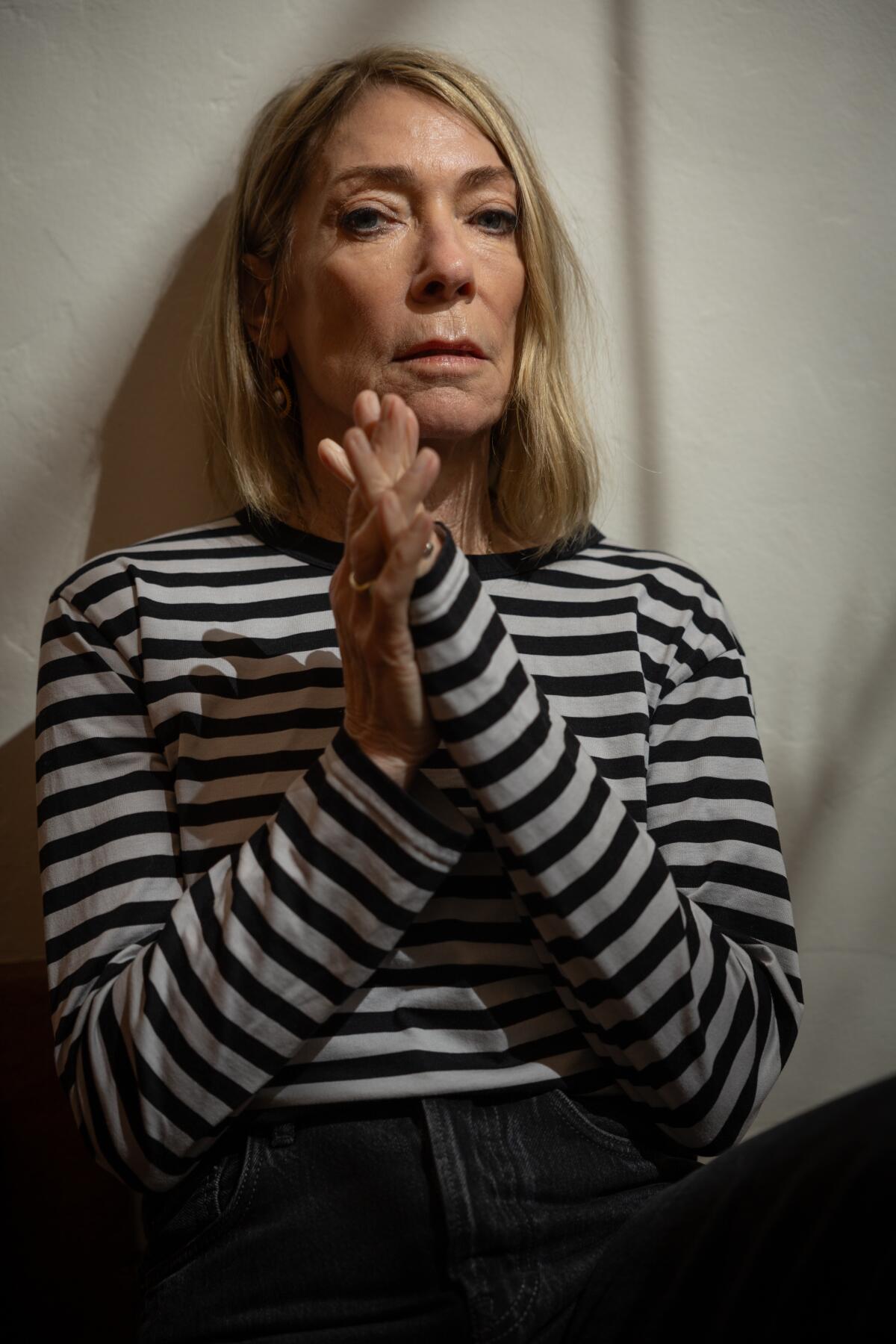
In a solo exhibition last year at the 303 Gallery in New York, Gordon included a painting called “The Collective,” a large canvas splashed with layers of pink, blue and red, with iPhone-shaped holes carved out. At the same gallery in 2018, she showed an abstract nude called “Airbnb Silverlake,” presaging her song “Airbnb” from her solo debut.
At the coffeehouse, a young woman at the next table leans in to thank Gordon for mentioning her late father, cinematographer Harris Savides, in Gordon’s 2015 memoir “Girl in a Band.” Savides was on the crew of “Last Days,” director Gus Van Sant’s fictionalized account of Cobain’s final days before his suicide. Gordon had a small but moving cameo as a caring record company exec visiting the despairing rocker named Blake and urging him to leave with her.
“Oh, my God. He was the sweetest,” Gordon says of the respected cinematographer. “Lovely to meet you. He was great, your dad.”
Over the decades, she has collaborated with an impressive collection of artists and musicians, including Yoko Ono, Kim Deal, Mike Kelley and Richard Kern, intermingling genres and disciplines.
“It feels good as a way to bridge the two worlds,” Gordon says of these connections and the forward motion they represent. “I really do feel like this record is like, ‘Well, this is the work I’m doing now.’”
More to Read
The biggest entertainment stories
Get our big stories about Hollywood, film, television, music, arts, culture and more right in your inbox as soon as they publish.
You may occasionally receive promotional content from the Los Angeles Times.
